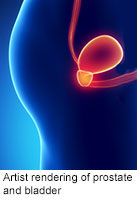
WEDNESDAY, Aug. 14 (HealthDay News) — A drug used to treat enlarged prostate and male pattern baldness also reduces a man’s risk of prostate cancer by nearly a third, according to a large new study.
The findings on nearly 19,000 men also overturn earlier concerns that treatment with finasteride — the agent in the prostate drug Proscar and the hair-loss drug Propecia — might promote the development of more virulent prostate cancers in men who contract the disease, researchers said.
Finasteride did not affect overall survival rates or survival rates after diagnosis with prostate cancer for men who did and did not receive the drug, said study lead author Dr. Ian Thompson, a urologist and professor at the University of Texas Health Science Center.
“If indeed the more high-grade cancers in the men taking finasteride were real, we would expect to find a higher death rate,” Thompson said. “The survival of these men was exactly the same.”
Published in the Aug. 15 issue of the New England Journal of Medicine, the study is an 18-year follow-up on the Prostate Cancer Prevention Trial, which took place in the late 1990s. Back then, the trial found that finasteride could reduce overall risk of prostate cancer by 25 percent — but that it increased by 27 percent the risk of high-grade prostate cancer in those men who did wind up with the disease.
The concern over the high-grade cancer findings led officials back then to decline recommending finasteride as a prostate cancer prevention tool. “Basically, this potential home-run prostate cancer intervention never happened,” Thompson said.
When checking back with the men involved in the earlier trial, researchers behind the new study found that the drug actually worked better than earlier reported in reducing prostate cancer risk.
They also found that detection of high-grade cancers occurred in 3.5 percent of prostate cancer patients who took finasteride and 3 percent of patients given a placebo. There was no difference between the finasteride and placebo groups regarding overall long-term survival or survival following a prostate cancer diagnosis.
“It shows that the higher proportion of high-grade disease doesn’t really matter, because it doesn’t affect the risk of death,” said Dr. Otis Brawley, chief medical officer for the American Cancer Society.
Brawley said the increased diagnosis of high-grade prostate cancer likely occurs due to finasteride’s effectiveness in shrinking enlarged prostates.
“You take Proscar for six months to a year and it halves the size of your prostate, but the cancer inside your prostate does not shrink,” Brawley said. “If I’m performing a biopsy on a smaller prostate, I’m more likely to hit that cancer than if I am sticking into a larger prostate. This drug wasn’t causing more prostate cancer. It’s causing more prostate cancer to be diagnosed.”
Since finasteride does not affect survival rates, its true value may lie in reducing the diagnosis of minor prostate cancers that should not be treated, Thompson and Brawley said.
Prostate cancer is the most commonly detected form of cancer in men, found in one in six men during their lifetimes, Thompson said. Prostate cancer kills only 3 percent to 5 percent of men, however.
Most men “will get away with it, dying of causes other than prostate cancer,” Thompson said.
Because of this, prostate cancer has become an overtreated disease, with men suffering side effects such as impotence and incontinence because they received treatment for a cancer that wasn’t likely to lead to their deaths, Brawley said.
“It does not affect a man’s risk of death at all to take finasteride, but if he takes finasteride it will lower his risk of being diagnosed with prostate cancer,” Brawley said. “Half to 60 percent of men who were diagnosed with localized prostate cancer, if it was never diagnosed, it would never have bothered them in their lifetimes. We cure some people who never need to be cured.”
More information
To learn more about prostate cancer, visit the U.S. National Cancer Institute.
Copyright © 2025 HealthDay. All rights reserved.

